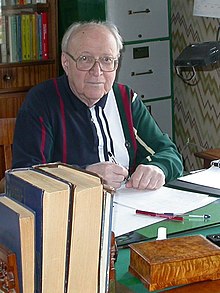E. B. Dynkin
| Eugene Dynkin | |
|---|---|

Eugene Dynkin at home in 2003. Photo courtesy of the Dynkin Collection.
|
|
| Born | Eugene Borisovich Dynkin 11 May 1924 Leningrad, Soviet Union |
| Died | 14 November 2014 (aged 90) Ithaca, New York, United States |
| Residence | Ithaca, New York, United States |
| Citizenship | United States |
| Fields | Mathematics |
| Institutions |
Moscow University Central Economic Mathematical Institute Cornell University |
| Alma mater | Moscow University |
| Doctoral advisor | Andrey Kolmogorov |
| Doctoral students |
Nicolai V. Krylov Igor Girsanov Fridrikh Karpelevich Anatoliy Skorokhod Ernest Vinberg Complete List |
| Notable awards | Leroy P. Steele Prize (1993) |
Eugene Borisovich Dynkin (Russian: Евге́ний Бори́сович Ды́нкин; 11 May 1924 – 14 November 2014) was a Soviet and American mathematician. He has made contributions to the fields of probability and algebra, especially semisimple Lie groups, Lie algebras, and Markov processes. The Dynkin diagram, the Dynkin system, and Dynkin's lemma are named after him.
Dynkin lived in Leningrad until 1935, when his family was exiled to Kazakhstan. Two years later, when Dynkin was 13, his father disappeared in the Gulag.
At the age of 16, in 1940, Dynkin was admitted to Moscow University. He avoided military service in World War II because of his poor eyesight, and received his M.S. in 1945 and his Ph.D. in 1948. He became an assistant professor at Moscow, but was not awarded a "chair" until 1954 because of his political undesirability. His academic progress was made difficult due to his father's fate, as well as Dynkin's Jewish origin; the special efforts of Andrey Kolmogorov, his Ph.D. supervisor, made it possible for Dynkin to progress through graduate school into a teaching position.
In 1968, Dynkin was forced to transfer from the Moscow University to the Central Economic Mathematical Institute of the USSR Academy of Sciences. He worked there on the theory of economic growth and economic equilibrium.
...
Wikipedia
